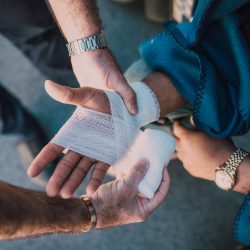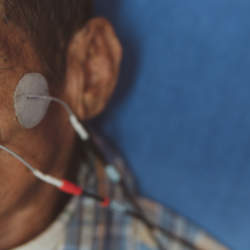Athlete’s foot is a skin condition caused by parasites such as microscopic fungi. Fungal in origin and highly contagious, it causes itching and redness, followed by peeling of the skin. If left untreated, athlete’s foot leads to deformation of the big toe joint and the nails.
Summer is a season when feet are often exposed to humidity, heat and perspiration. These conditions can encourage the development of foot fungus. Foot fungus is a common ailment that can be embarrassing and even painful. Fortunately, there are simple and effective ways of preventing and treating athlete’ s foot.
What is athlete’s foot?
Athlete’s foot is a fungal infection of the skin on the feet, generally caused by dermatophyte fungi.
What causes it?
The fungi responsible for athlete’s foot thrive in warm, damp environments. Places such as swimming pools, public showers and changing rooms are ideal breeding grounds for these organisms. Wearing closed, non-breathable footwear also contributes to the creation of an ideal environment for fungal growth. Excessive sweating, often aggravated by inadequate footwear in the warmer months, increases the risk of fungal growth.
It is therefore crucial to minimise exposure to these high-risk environments and to choose suitable footwear that allows the foot to breathe properly. Using sandals in damp public spaces and avoiding sharing towels or shoes are essential preventive measures.
Personal hygiene habits
Inadequate personal hygiene can considerably increase the risk of developing athlete’s foot. Failure to dry feet thoroughly after a shower or bath, especially between the toes, can create an environment conducive to fungal infections. Similarly, wearing damp socks or dirty shoes for long periods of time can encourage the proliferation of fungi.
To prevent fungal infections, it is advisable to maintain a strict foot care routine. This includes washing feet daily, using antifungal soaps if necessary, and changing socks regularly to avoid moisture build-up. Synthetic socks that wick away moisture are preferable to cotton socks that retain perspiration.
Symptoms
Recognising the symptoms of athlete’s foot in its early stages is crucial to effective and rapid treatment. These infections, which often occur in the warmer months, can range from a simple inconvenience to serious discomfort. Here are the signs to look out for:
Warning signs
The first symptoms of athlete’s foot are often subtle, but gradually worsen if left untreated. Itching is usually the first sign, often overlooked until it becomes persistent and uncomfortable. Redness follows, indicating inflammation and irritation. A noticeable odour may also develop, caused by the breakdown of skin tissue and the presence of fungi. These signs should prompt immediate attention to foot hygiene and care.
Progression of symptoms
As the condition worsens, additional symptoms may appear. Cracking skin, especially between the toes and on the soles of the feet, may occur, making daily activities painful. Discoloured nails-varying from yellow to brown or even white-are a telltale sign of a fungal infection under and around the nails. This discolouration is often accompanied by a thickening of the nails, which can become brittle and break down easily.
It is important to treat these symptoms promptly to prevent the spread of infection and other complications. Maintaining good foot hygiene and seeking appropriate treatment are essential steps in effectively managing foggy foot conditions.
How can foot fungus be prevented?
- Foot hygiene: The first step in preventing athlete’s foot is to maintain good foot hygiene. This means washing your feet every day with water and mild soap. Then dry your feet thoroughly, especially between the toes, and wear clean shoes and socks.
- Change shoes: It’s important to change shoes every day to allow moisture to evaporate and reduce fungus growth.
- Ventilated shoes: Wearing light, airy shoes, such as sandals or flip-flops, can also help prevent athlete’s foot by allowing better air circulation and reducing perspiration.
- Avoid damp shoes: It’s important to avoid wearing damp shoes or socks for long periods, as this encourages fungus growth.
How can foot fungus be treated?
Antifungal medicines: Antifungal medicines are often prescribed to treat athlete’s foot. They can be applied topically, in the form of creams, lotions or powders, or taken orally. It is important to follow the doctor’s or pharmacist’s instructions to ensure proper use of the medication.
Foot hygiene: Good foot hygiene is also important for treating athlete’s foot. It is recommended that you wash your feet every day, dry your feet thoroughly, especially between the toes, and wear clean shoes and socks.
Steps to take to relieve athlete’s foot
When fungal infections first appear, you can prevent them from proliferating by choosing non-synthetic, ventilated shoes. In addition, avoid materials that can make your feet sweat, and dry them thoroughly after washing. If you have to wear socks, make sure they are made of cotton, bamboo fibre or wool.
After your visit to the podiatrist, you can also opt for natural remedies. These will help relieve the discomfort and prevent recurrence.
Professional chiropodist
Consulting a professional pedicurist can help treat athlete’s foot. A pedicurist can remove infected areas of skin and nails, as well as recommend products to treat the fungus and prevent re-infection. It is important to choose a competent and experienced pedicurist to ensure proper and effective care.
Natural remedies
Some natural remedies can help treat athlete’s foot, such as apple cider vinegar, tea tree oil and bicarbonate of soda. However, it is important to consult a healthcare professional before using any natural remedies, as they may interact with other medicines or have undesirable side effects.
Change your shoes and socks
Regular changes of shoes and socks can also help treat athlete’s foot by reducing the growth of fungi. It’s important to choose light, airy shoes and wear cotton or wool socks to absorb moisture.
Avoiding risk factors
It is important to avoid risk factors for athlete’s foot, such as hot, humid environments, closed shoes and damp socks. Avoiding walking barefoot in public places, such as changing rooms and showers, can also reduce the risk of infection.
Beautiful, healthy feet thanks to essential oils
To prevent complications such as athlete’s foot, inflammation and poor circulation, it’s essential to look after your feet.
Walking, closed shoes, arthritis or poor circulation can all cause discomfort in the feet. Unfortunately, we don’t always know how to relieve the discomfort. Fortunately, there are essential oils for this purpose.
EMTRIX Plus Tea Tree Essential Oil for the natural treatment of damaged nails acts as an antifungal and antiseptic. In fact, it is highly effective in treating rheumatic pain. Tea tree essential oil has an anti-inflammatory tonic action: very effective for tired feet. In short, it’s a natural relaxant that soothes calluses, fights fungal infections and relaxes the feet.
A blend of almond and rosehip vegetable oils is also one of the best treatments for foot health and beauty. These oils are ideal for treating athlete’s foot and dry or inflamed skin. Finally, they are rich in vitamins, minerals and essential trace elements.
Soften your nails with Nailner Stylet products
Nailner Nail Fungus Stylet 4 ml is a practical, effective treatment for nail fungus. What’s more, its solution penetrates the nail and effectively killsonychomycosis to eliminate bacteria and fungi on finger and toenails.
Its formula, rich in moisturising active ingredients, helps to correct the dryness of nails affected by fungal infections, while helping to moisturise them as they grow back. It also contains an active ingredient that restores shine to the nail in just 7 days.
Nailner Stylet is easy to use and should be applied twice a day for the first 4 weeks, over the entire nail surface and the lower part of the nail tip. After that, once a day is enough until a healthy nail grows back.
Foot fungus can be embarrassing and painful, but it can be successfully treated by simple and effective means, such as maintaining good foot hygiene, changing shoes and socks regularly, consulting a pedicure professional and using antifungal medication. By following these recommendations, you can enjoy a carefree summer and avoid the complications of foot fungus.
FAQ
- Are athlete’s foot infections contagious? Yes, athlete’s foot is contagious and can spread from person to person.
- Are natural remedies effective in treating athlete’s foot? Some natural remedies can help treat athlete’s foot, but it is important to consult a healthcare professional before using them.
- How can foot fungus be prevented in children? It is important to teach children to maintain good foot hygiene and to avoid walking barefoot in public places.
- Can athlete’s foot cause complications? Yes, if not treated properly, athlete’s foot can cause complications, such as bacterial infections or severe inflammation.
- Can athlete’s foot be completely avoided? It is difficult to avoid foot fungus completely, but by following foot hygiene recommendations and avoiding risk factors, the risk of infection can be significantly reduced. It is also important to treat any fungal infection promptly to avoid complications.





